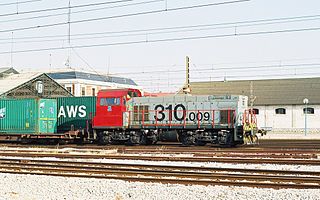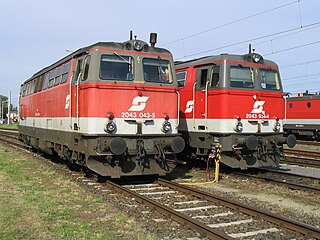| Renfe Class 250 | |||||||||||||||||
|---|---|---|---|---|---|---|---|---|---|---|---|---|---|---|---|---|---|
 Locomotive 250 004 in November 2008 | |||||||||||||||||
| |||||||||||||||||
| |||||||||||||||||
| |||||||||||||||||
| |||||||||||||||||
The Renfe Class 250 is a class of electric locomotives operated by Renfe in Spain, built by Krauss Maffei and CAF. [1]
| Renfe Class 250 | |||||||||||||||||
|---|---|---|---|---|---|---|---|---|---|---|---|---|---|---|---|---|---|
 Locomotive 250 004 in November 2008 | |||||||||||||||||
| |||||||||||||||||
| |||||||||||||||||
| |||||||||||||||||
| |||||||||||||||||
The Renfe Class 250 is a class of electric locomotives operated by Renfe in Spain, built by Krauss Maffei and CAF. [1]
The fleet consists of 35 Class 250 locomotives, numbered 250 001–035, and five Class 250.6 locomotives, numbered 250 601–605, which are equipped with chopper control. [2]
The locomotives have a C-C wheel arrangement, [3] and are equipped with monomotor bogies, which have switchable gear ratios. [2] Their maximum axle load is 22 tonnes. [1]
The locomotives were introduced in 1982. A total of 40 locomotives have been built. They are mainly used on freight services by Renfe's Cargas freight and Transporte Combinado intermodal divisions. [2]

Alstom Traxx is a modular product platform of mainline diesel-electric and electric locomotives produced originally by Bombardier Transportation and later Alstom, which was built in both freight and passenger variants. The first version was a dual-voltage AC locomotive built for German railways from the year 2000. Later types included DC versions, as well as quadruple-voltage machines, able to operate on most European electrification schemes: 1.5/3.0 kV DC and 15/25 kV AC. The family was expanded in 2006 to include diesel-powered versions. Elements common to all variants include steel bodyshells, two bogies with two powered axles each, three-phase asynchronous induction motors, cooling exhausts on the roof edges, and wheel disc brakes.

The M250 series, branded "Super Rail Cargo", is a freight electric multiple unit (EMU) train type operated by Japan Freight Railway in Japan. It entered service in 2004 with the objective of reducing emissions and carrying general freight for small package forwarders. The M250 series is JR Freight's first container train with distributed traction. It is manufactured by Nippon Sharyo, Kawasaki Heavy Industries, and Toshiba.

The Deutsche Reichsbahn Class 250 is a German electric locomotive used on freight trains. It is nicknamed the "Electric Container" or "Powercontainer" due to its distinctive carbody shape. It was the most powerful locomotive in the former GDR and is still in use with Deutsche Bahn AG.

The EuroSprinter family of electric locomotives is a modular concept of locomotives for the European market built by Siemens Mobility. The internal Siemens product name is ES 64, with ES for EuroSprinter and the number 64 indicating the 6,400 kW power at rail.

The EMD G16 is a diesel locomotive built by General Motors in the US and under licence by Clyde Engineering in Australia and MACOSA in Spain. It has been used in Australia, Brazil, Egyptian Railways, Hong Kong, Israel Railways, Mexico, Spain, Yugoslav Railways and on the successor Croatian Railways, Slovenian Railways, Serbian Railways, Macedonian Railways, Republika Srpska Railways, Kosovo Railways and Railways of the Federation of Bosnia and Herzegovina.

The VL10 is an electric two-unit mainline DC freight locomotive used in the Soviet Union and is still operated today by the state owned Russian rail company RZhD, Ukrainian Railways and Georgian Railway. The initials VL are those of Vladimir Lenin, after whom the class is named.

The Stadler Euro is a class of diesel-electric locomotives built by Stadler Rail for the European market. It is available in two basic variants, the four-axle Euro 3000, and the six-axle Euro 4000. These locomotives are powered by EMD 710 prime movers. A six-axle electric-only variant is marketed as Euro 6000; it is also built for the Iberian gauge.

The Renfe Series 333 are high power six-axle diesel-electric locomotives built in the 1970s; at the time of their introduction they were the most powerful non-electric locomotives in Spain.

The Class EF66 (EF66形) is a six-axle, three-bogied (Bo′Bo′Bo′) DC electric locomotive designed for fast freight used by Japanese National Railways (JNR) and later operated by its descendants JR West and JR Freight. As of 1 April 2016, 39 locomotives remained in service, all operated by JR Freight.
Stadler Rail Valencia SAU is a Spanish company, mainly producing products for the railway industry, subsidiary of Stadler Rail.

The Class 151 is an electric heavy freight locomotive built for German Federal Railways between 1972 and 1978. They were built as a replacement for the ageing Class 150, in order to cope with the increased requirements of this type of locomotive, in particular the desire of a 120 km/h (75 mph) top speed.

The Renfe Class 252 are a series of Bo'Bo' electric locomotives, built by CAF, Meinfesa, Siemens and Krauss-Maffei for RENFE. 15 units were built for the AVE Madrid–Seville high speed line in, and 60 units constructed for general use to Iberian gauge (1668mm).

The Renfe classes 319.2, 319.3 and 319.4 are six axle Co'Co' medium power mainline diesel-electric locomotives manufactured by Macosa using General Motors Electromotive division components under license.

The Renfe Class 319 was a class of mainline medium-high powered diesel electric locomotives built by General Motors Electro-Motive Division and by Macosa for the state railways of Spain.

The Renfe Class 310 is a class of 60 four axle Bo'Bo' diesel-electric locomotives for shunting and freight built by Meinfesa with General Motors Electromotive Division components.

The Renfe Class 269 is a class of electric locomotives operated by Renfe in Spain. They were built by CAF and Macosa under license from Mitsubishi.

The Renfe Class 251 is a class of electric locomotives operated by Renfe in Spain. They are aesthetically and conceptually based on the JNR Class EF66 operated in Japan, but they have many differences in mechanical design and power output, as well as manufacturers.

The ÖBB Class 2143 is a class of diesel-hydraulic locomotives operated by Austrian Federal Railways (ÖBB) in Austria.

The ÖBB Class 2043 is a class of diesel-hydraulic locomotives operated by Austrian Federal Railways (ÖBB) in Austria.

The Renfe Class 321 is a class of diesel-electric locomotives operated by Renfe in Spain, designed by Alco and built by them and by Euskalduna under licence.
![]() Media related to Renfe Class 250 at Wikimedia Commons
Media related to Renfe Class 250 at Wikimedia Commons